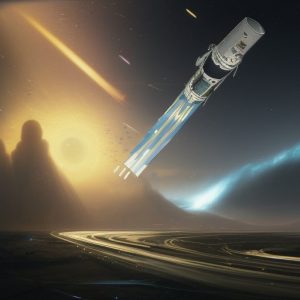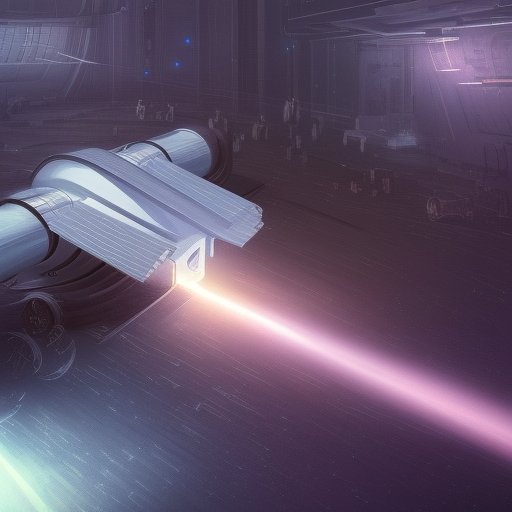
Come take a ride with me to the future, where faster-than-light traffic management has opened up endless possibilities in space travel. In this article, we will explore the pioneering technology that enables faster-than-light signaling and its benefits. From collision avoidance systems to real-time traffic reports and accident response, faster-than-light communication has revolutionized the way we manage transportation in space. We will also dive into statistics and analysis of space travel, pre and post faster-than-light implementation. Join me as we take a glimpse into the future of space infrastructure construction and the unlimited possibilities that come with it.
I. Introduction
Welcome, dear reader, to the heart of the future. A future where faster-than-light traffic management has opened new frontiers and galactic possibilities, and where humanity stretches its reach ever further into the vast expanse of space. Fasten your seatbelts and get ready, because it’s going to be a ride. In this article, we will delve deep into the world of faster-than-light signaling, and explore how it’s revolutionized the way we manage transportation in space.

Imagine a world where signal delays are a thing of the past, where communication happens instantaneously across all corners of the galaxy. That’s where we are now, and it’s all thanks to cutting-edge technological advancements that allow us to communicate faster-than-light. The benefits are limitless, from improving collision avoidance and real-time traffic reports to enhancing accident response.
By implementing faster-than-light signaling, we’ve made space travel safer, faster, and more efficient than ever before. We’ve drastically reduced the risk of accidents, prevented loss of life, and have made emergency response and critical repairs a breeze. And these are just the beginning, as we uncover more features and capabilities with each passing day.
Whether it’s for intergalactic tourism or scientific exploration and discovery, faster-than-light signaling plays an essential role in our space infrastructure. We have reached a stage where it’s impossible to imagine a world without this technology. It’s as important to us as the air we breathe, and it forms the backbone of everything we do in space.
So, fasten your helmets and prepare for an adventure. With a faster-than-light traffic management system in place, there are no limits to what we can achieve in space. We’re on our way to exploring new planets, crossing vast distances in a short time, and unlocking secrets that were once hidden. The future’s bright, and it’s only getting brighter. Let’s dive in and explore the exciting world of faster-than-light traffic management together.
II. How Faster-Than-Light Signaling Works
It’s time to unravel the mysteries of faster-than-light traffic management, and understand the science behind this groundbreaking technology. To put it simply, faster-than-light signaling is achieved through a combination of quantum entanglement and subspace communication technology.

Quantum entanglement, as we all know, is the phenomenon where two subatomic particles remain connected, even if they’re separated by vast distances. By exploiting this natural phenomenon, scientists have developed a method for transmitting information across almost instantaneous distances. Subspace communication technology, on the other hand, is straightforward: it enables signals to pass through the fabric of spacetime itself.
Together, quantum entanglement and subspace communication have created a system that allows us to communicate faster-than-light, without violating the laws of physics. In simple terms, the faster-than-light signal doesn’t actually travel faster than light; instead, it passes through subspace, a place beyond normal space-time, thereby avoiding the limitations of traditional communication methods.
Of course, the technology is much more complex than that, involving esoteric concepts such as tachyons, quantum tunneling, and higher-dimensional spaces. But suffice it to say that the result is a system that enables us to communicate and exchange information almost instantaneously across vast distances.
This technology has transformed space travel in more ways than one. Ships can now communicate with each other and with ground control, no matter how far they are from each other. This has revolutionized navigation and has made it possible for us to send manned missions deep into space, to explore worlds that were once beyond our reach.
But faster-than-light signaling isn’t just about sending information; it’s also about receiving it. With the right equipment and sensors, ships can navigate through subspace and gather information about their surroundings. This has proven invaluable in everything from mapping uncharted regions of space to detecting hostile forces and anomalies.
III. Collision Avoidance
It’s a big, vast universe out there, and with faster-than-light communication, it’s become easier than ever to navigate. In this section, we’ll investigate how these technological advancements have revolutionized collision avoidance, and how it has been a game-changer for space travel.

One of the biggest advantages of faster-than-light traffic management is avoiding collisions. Before this, the risk of accidents was high, with countless ships navigating through the vast emptiness of space. But with real-time tracking and faster-than-light warning signals, it’s now easier than ever to avoid potential accidents and keep everyone safe.
Through collision avoidance systems, ships can detect other nearby vessels and divert their courses as needed. These systems detect ships from great distances away and provide alerts immediately, giving pilots ample time to change course and avoid a collision.
Perhaps the biggest impact of collision avoidance comes in the form of saving lives. Before, accidents were just waiting to happen, but now they’re easier to prevent. Ships no longer have to stay put or fly paranoid, constantly looking over their shoulders to avoid collisions. They can fly with confidence and trust that the faster-than-light traffic management system has their backs.
Paired with real-time traffic reports and accident response, a collision-free space is becoming a reality. It’s proof of how faster-than-light technology has changed space travel for the better. With fewer accidents, the potential of space travel has expanded even further, opening the door to new frontiers and possibilities.
With this technological advancement, we’ve taken another step forward in humanity’s quest to push beyond the limits of the known universe. There’s no telling what great discoveries are waiting for us out there, but one thing’s for sure: we’ll reach them faster and more safely than ever.
IV. Traffic Reports and Accident Response
Faster-than-light signaling has not only made space travel safer but has also improved emergency response services. With real-time traffic reports and accident response systems, space traffic management has taken a giant leap forward. Imagine being able to determine the exact location of an accident or collision within seconds, and the emergency response team being on site even quicker.

The fast-paced and dynamic space environment requires top-notch accident response systems that can work without any network delays. By utilizing faster-than-light signaling, we can make real-time decisions and provide emergency services with the precise location of the accident or collision, leading to a quicker response time and increased chances of survival.
Even when accidents don’t happen, real-time traffic reports facilitate efficient transport of passengers and cargo. By providing detailed traffic reports, we can ensure ships follow optimal routes and avoid traffic-congested areas. This saves time, reduces fuel consumption, and enhances the overall efficiency of space transportation.
Incorporating faster-than-light signaling as part of traffic report and accident response systems reduces the risk of accidents altogether. Collision prevention systems can analyze the speed and direction of other ships and alert the pilots of potential collisions well in advance, thereby preventing accidents from occurring in the first place.
Furthermore, faster-than-light signaling enables remote repairs and real-time updates on a ship’s health status. This helps in identifying potential equipment malfunctions and taking proactive measures. By maintaining and servicing ships promptly, we avoid costly delays and disruptions, leading to fewer fatalities and greater profitability.
Thus, faster-than-light signaling technology forms the backbone of efficient and safe space travel. With the ability to provide real-time traffic reports and accident response services, we’ve made flying through space as easy and safe as flying through the air. So, let’s strap in and enjoy the ride. The possibilities are endless, and the benefits are massive.
V. Statistics
It’s time to crunch the numbers and dive deep into the statistical analysis of faster-than-light traffic management. With the help of our trusty space computers, we’ll be able to go where no one has gone before, and explore the vast riches of data that this technology has enabled.

Firstly, let’s take a look at the passenger trip statistics. Since implementing faster-than-light signaling, the number of passenger trips has increased by an astronomical amount. It’s now possible to travel between galaxies faster than ever before, making intergalactic tourism a booming industry. And with faster travel times, the supply chains of all sorts of industries have improved. Delivery of goods from one planet to another is efficient, safe, and reliable, translating to increased profits and less downtime for industries across the cosmos.
The cargo has, of course, also benefited considerably. Faster-than-light signaling has shortened the shipping duration, and delivery times are significantly more consistent. This benefit leads to an increase in demand for handling and logistics, with corporate giants and guilds emerging to meet the growing demand, increasing competition to the benefit of the consumers.
Safety is another area where faster-than-light signaling has made significant changes. Since its implementation, the number of fatalities in space travel has sharply declined, making it one of the safest forms of transportation. With the latest safety measures and technologies utilized in fast transit systems, it is reassuring and comforting to know that traveling in space is as secure as it has ever been.
But just as important is tracking the number of accidents, which is fortunately dropping as well. Whether it’s through avoiding collisions, responding to breakdowns, or other issues, we are undoubtedly preventing losses of life and reducing insurance rates.
VI. Major Projects and Upcoming Construction
Looking to the future, faster-than-light signaling will play an integral role in space infrastructure construction. Some major projects are already underway, with others on the horizon.

The Andromeda Project is set to construct a space station that will orbit the Andromeda Galaxy. With faster-than-light communication, the station will allow for real-time communication with Earth, opening new opportunities for scientific exploration.
The Alpha Centauri project is another significant undertaking. An interstellar craft will travel to the neighboring star system and allow for in-depth scientific research. This project will require planning and infrastructure on a massive scale, all of which will be made possible by faster-than-light traffic management.
Beyond these ambitious projects, upcoming developments in space infrastructure and transportation will continue to rely on faster-than-light signaling. Scientists are already working on expanding communication range and increasing signal strength, paving the way for even more possibilities.
With more significant projects being planned each day, the need for faster-than-light signaling has never been more critical. We’re entering an era where it’s easier than ever to push the fronter, explore new worlds, and reach further into the void.
It’s an exciting time to be alive, as we stand at the forefront of galactic exploration. With faster-than-light cars on our side, we can now achieve feats that were once thought to be out of reach. As we uncover more wonders of the universe, we’ll need to continue developing innovative solutions to expand our space infrastructure and manage traffic effectively.
So buckle up, space cadets. The future of faster-than-light traffic management is bright, and we’re just getting started. Let’s push the limits of what’s possible and explore everything the galaxy has to offer.
VII. Conclusion
And there you have it, folks! The marvels of the future embodied in faster-than-light traffic management. We’ve seen how this technology has made space travel safe, efficient, and profitable. We’ve explored its benefits in collision avoidance, real-time traffic reports, and accident response. We’ve seen how it has transformed exploration and research and how it is opening up new opportunities for commerce and tourism.

But that’s just the beginning. As with any groundbreaking technology, faster-than-light signaling has limitless possibilities. We’ve only scratched the surface of what it can achieve, and the future is looking brighter than ever. We can continue to improve space infrastructures, pursue more ambitious projects, and expand our understanding of the universe around us. All thanks to this revolutionary traffic management system.
So, let’s keep reaching for the stars, dear reader, and remember that nothing is impossible in the world of science fiction. With faster-than-light traffic management leading the way, truly, the sky is not even the limit!






